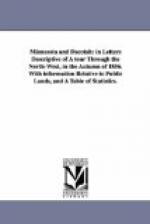Now let me say a word about this Red River of the North, for it is beginning to be a great feature in this upper country. It runs north, and empties into Lake Winnipeg, which connects with Hudson’s Bay by Nelson River. It is a muddy and sluggish stream, navigable to the mouth of Sioux Wood River for vessels of three feet draught for four months in the year. So that the extent of its navigation within the territory alone (between Pembina and the mouth of Sioux Wood River) is 417 miles. Buffaloes still feed on its western banks. Its tributaries are numerous and copious, abounding with the choicest kinds of game, and skirted with a various and beautiful foliage. It cannot be many years before this magnificent valley shall pour its products into our markets, and be the theatre of a busy and genial life.
One of the first things which drew my attention to this river was a sight of several teams travelling towards this vicinity from a north-westerly direction. I observed that the complexion of those in the caravan was a little darker than that of pure white Minnesotians, and that the carts were a novelty. “Who are those people? and where are they from?” I inquired of a friend. “They are Red River people, just arrived— they have come down to trade.” Their carts are made to be drawn by one animal, either an ox or a horse, and are put together without the use of a particle of iron. They are excellently adapted to prairie travelling. How strange it seems! Here are people who have been from twenty to thirty days on their journey to the nearest civilized community. This is their nearest market. Their average rate of travelling is about fifteen miles a day, and they generally secure game enough on the way for their living. I have had highly interesting accounts of the Red River settlement




